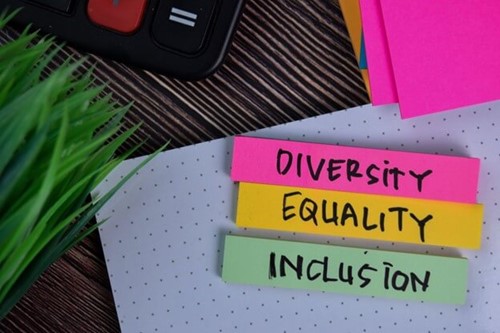As an employer, you should be in no doubt aware that gender equality should be a given. Equal opportunities for all current and prospective employees will create a more diverse and engaged workforce – and this is positive.
The question for many employers is how can I achieve this? Perhaps your business operates in a traditionally male-dominated arena. Equally, the challenge could be educating stakeholders on the benefits of gender diversity.
This article explores gender diversity and how you can create more diverse teams. If you need immediate support on equality, diversity and inclusivity, contact Croner today.
What is gender diversity?
Creating gender diversity in your workplace is about employing staff of all gender identities. The term gender diversity refers to a diverse expression of gender beyond the binary framework. For example, an employee may not believe in the concept of binary gender (expressing yourself as male or female).
If you're always hiring people of the same gender it can be limiting for your company. Think about how diverse genders create diverse outputs for your customers and clients. If your company promotes individualism then you can also limit discrimination.

What happens if my business isn’t gender diverse?
There are numerous risks if your working environment isn’t gender diverse and inclusive. There is legislation in place under the Equality Act 2010 which creates a legal duty for employers to promote workplace diversity. Sex and gender reassignment are both protected characteristics which would be covered under the above Act.
If your workplace discriminates against anyone on the basis of gender this could leave you open to litigation. This could cost your business thousands, paying out on claims at tribunal.
Failure to close the gender gap could also have a negative impact on your culture. Employees who feel there is an inherent gender bias could leave. This will lead to low staff retention rates. Similarly, your staff could become disengaged and unproductive.
How can I increase gender diversity?
There are a range of steps you can take as an employer to make your business more gender diverse. Your action points don't always have to amount to a huge overhaul necessarily. Small changes can certainly improve the balance of men and women in your employment.
Make sure job adverts are gender neutral
Unconscious biases can mean you end up recruiting a less diverse executive, as an example. The key to a more gender-diverse workforce is understanding that gender equality begins at the recruitment stage.
Make sure that you’re recruiting using multiple platforms. Look at LinkedIn, online and offline job boards, external recruitment agencies and internal adverts). The more exposure your job listing gets, the more likely you will get more diverse applicants.
Make sure that the language of your adverts is gender-neutral in order to avoid negative perceptions. Avoid phrases like “salesman” or “waitress” as this is specific to a gender, even if it may be accidental. Once a candidate gets to the interview stage, try to have more than one gender represented by those conducting the interview.
Remember it is permissible for you to hire a specific gender if that gender is represented poorly in your workforce. This is deemed “positive action” under the Equality Act 2010.
 .
.
Close the gender pay gap
Gender pay gap reports are now the norm. As a result, many companies are looking at how gender diverse their senior roles are. If your business is in the same boat there are steps you can take to improve equality in pay and leave.
Firstly, make sure you have clear job descriptions and requirements for your roles. This clarity will help encourage applicants to apply based on experience and skills rather than gender. If you can offer things like increased pay on family-friendly leave, such as maternity leave, this can also be helpful.
You might choose to carry out voluntary gender pay gap reporting and regularly review staff pay and bonuses. This will help you to evaluate whether there is gender bias in your business. It will also show shareholders, customers and employees that you are proactive in promoting gender diversity.
Have clear policies and procedures for gender equality
Clear policies also help to increase the overall happiness of your workforce as you will be seen as a supportive employer.
No matter how big or small your company is, it's important to have clear policies. Gender diversity can be improved, for example, by having a sexual harassment policy. You can also provide training on workplace conduct.
Improve company culture
It can be difficult to quantify culture. That said, you can look at things like:
- Staff retention rates.
- Exit interviews to understand why employees are leaving.
- Glassdoor or job board employee reviews.
These will give you some indication of your business culture and how your employees see it. In order to improve culture specifically for gender diversity there should be an emphasis on inclusivity.
Remember that irrespective of gender, your employees should feel like they can be themselves without any worry. This helps to cultivate a sense of belonging in your business.
Honesty and transparency are also key to creating lasting change. Have formal and informal chats about being more gender diverse. Your team can help influence you on potential changes you plan on making.

Can Croner help with gender diversity?
If you ignore gender diversity, you could indirectly end up facing discrimination claims. In the worst-case scenario, this could see you paying compensation and losing valuable employees. You may also end up suffering from damage to your business' reputation.
From building your policies to fixing your hiring practices, our HR advisors are here to help.
Have questions about gender diversity in your workplace? Speak to a Croner expert in regard to any HR or employment law issue on 0800 470 2755.
Related resources
Categories
- Business Advice
- Culture & Performance
- Disciplinary & Grievances
- Dismissals & Conduct
- Employee Conduct
- Employment Contracts and Documentation
- Employment Law
- Employment Rights Bill
- End of Contract
- Equality & Discrimination
- Health & Safety
- Hiring and Managing
- Leave & Absence
- Managing Health & Safety
- Moving
- Occupational Health
- Pay & Benefits
- Recruitment
- Risk & Welfare




